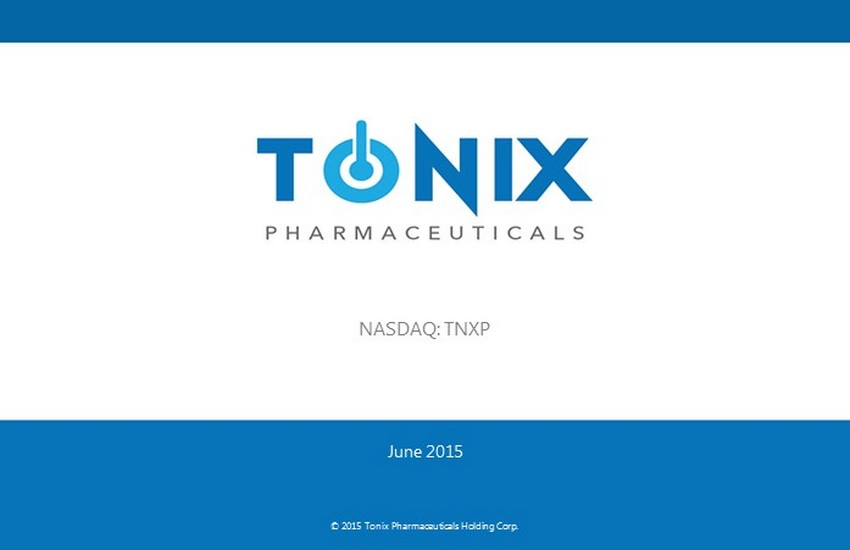
Exhibit 99.01

NASDAQ: TNXP June 2015 © 2015 Tonix Pharmaceuticals Holding Corp.
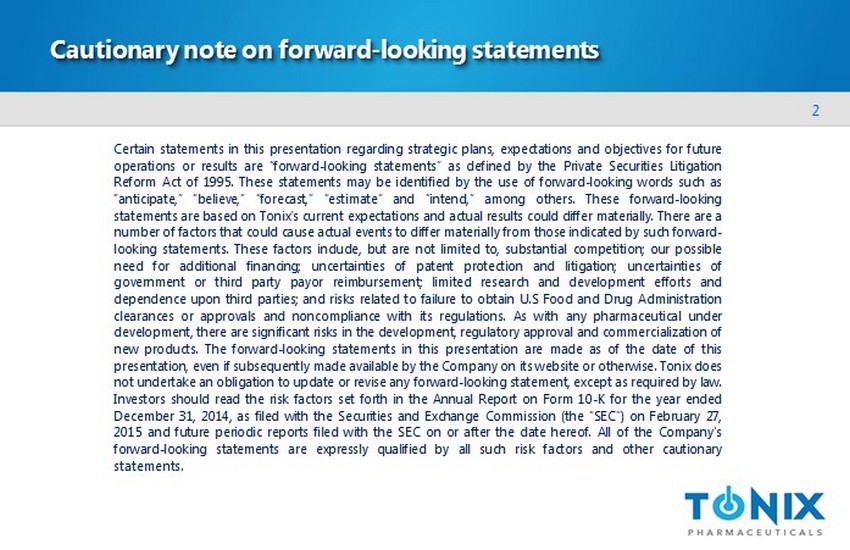
2 Cautionary note on forward - looking statements Certain statements in this presentation regarding strategic plans, expectations and objectives for future operations or results are “forward - looking statements” as defined by the Private Securities Litigation Reform Act of 1995 . These statements may be identified by the use of forward - looking words such as “anticipate,” “believe,” “forecast,” “estimate” and “intend,” among others . These forward - looking statements are based on Tonix’s current expectations and actual results could differ materially . There are a number of factors that could cause actual events to differ materially from those indicated by such forward - looking statements . These factors include, but are not limited to, substantial competition ; our possible need for additional financing ; uncertainties of patent protection and litigation ; uncertainties of government or third party payor reimbursement ; limited research and development efforts and dependence upon third parties ; and risks related to failure to obtain U . S Food and Drug Administration clearances or approvals and noncompliance with its regulations . As with any pharmaceutical under development, there are significant risks in the development, regulatory approval and commercialization of new products . The forward - looking statements in this presentation are made as of the date of this presentation, even if subsequently made available by the Company on its website or otherwise . Tonix does not undertake an obligation to update or revise any forward - looking statement, except as required by law . Investors should read the risk factors set forth in the Annual Report on Form 10 - K for the year ended December 31 , 2014 , as filed with the Securities and Exchange Commission (the “SEC”) on February 27 , 2015 and future periodic reports filed with the SEC on or after the date hereof . All of the Company's forward - looking statements are expressly qualified by all such risk factors and other cautionary statements .

3 Developing innovative medicines for large and growing markets Common and chronic disorders of the central nervous system ( CNS) Next - generation medicines with transformative treatment potential Late - stage candidates supported by human experience C apitalized to achieve key readouts in all of our clinical - stage programs
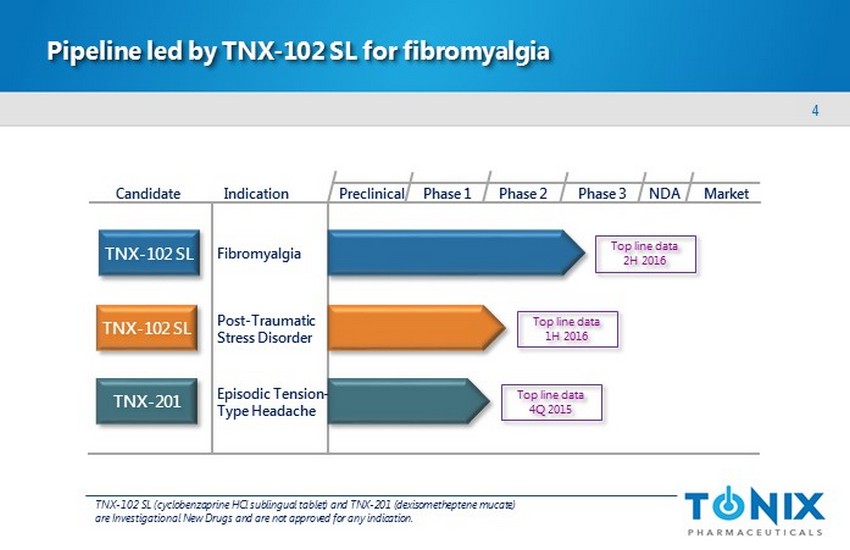
4 Pipeline led by TNX - 102 SL for fibromyalgia Preclinical Phase 1 NDA Market Candidate Indication Phase 2 Phase 3 TNX - 102 SL (cyclobenzaprine HCl sublingual tablet) and TNX - 201 ( dexisometheptene mucate ) are Investigational New Drugs and are not approved for any indication. TNX - 102 SL TNX - 102 SL TNX - 201 Post - Traumatic Stress Disorder Fibromyalgia Episodic Tension - Type Headache Top line data 2H 2016 Top line data 1 H 2016 Top line data 4Q 2015
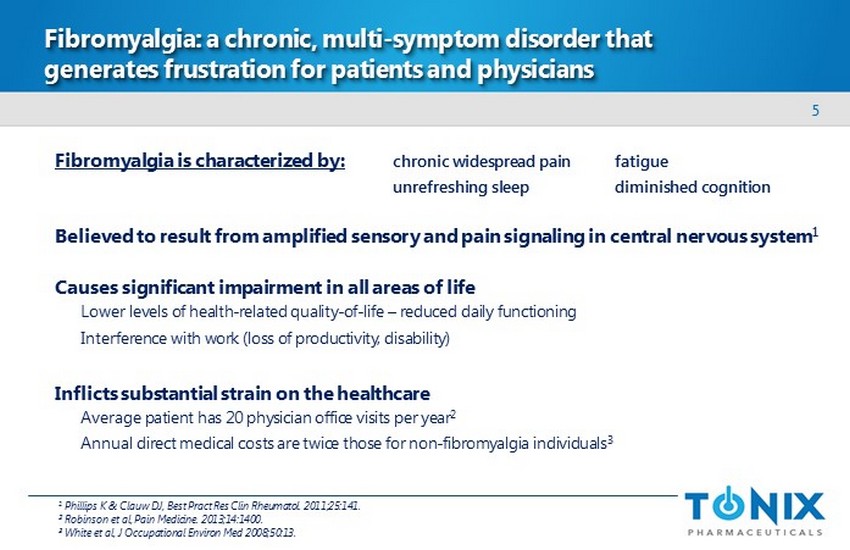
5 Fibromyalgia: a chronic, multi - symptom disorder that generates frustration for patients and physicians 1 Phillips K & Clauw DJ, Best Pract Res Clin Rheumatol . 2011;25:141. 2 Robinson et al, Pain Medicine. 2013;14:1400. 3 White et al, J Occupational Environ Med 2008;50:13. Fibromyalgia is characterized by: chronic widespread pain fatigue u nrefreshing sleep diminished cognition Believed to result from amplified sensory and pain signaling in central nervous system 1 Causes significant impairment in all areas of life Lower levels of health - related quality - of - life – reduced daily functioning Interference with work (loss of productivity, disability) Inflicts substantial strain on the healthcare Average patient has 20 physician office visits per year 2 Annual direct medical costs are twice those for non - fibromyalgia individuals 3

6 Affects 2 - 6% (5 - 15 million) Americans 1 and typically persists for years to decades Onset most frequent in the 30’s - 40’s, predominantly in females Diagnosis rate of 1.1% = 2.7 million U.S. adults ; suggests under - diagnosis Among those diagnosed, 85% receive treatment 2 = 2.3 million U.S. adults A pproved drugs achieved 2014 U.S. sales of $1.2 billion in fibromyalgia 4 Represents about 5.6 million prescriptions 3 Total U.S. market for fibromyalgia (combined on - and off - label usage) is estimated to be >22 million prescriptions annually 2,3 Fibromyalgia is a large market, but remains under - diagnosed… 1 Lawrence et al, Arthritis Rheum 2008;58:26; Vincent et al, Arthritis Care Res 2013;65:786; Jones et al, 2015;67:568. 2 Robinson RL et al, Pain Med 2012;13:1366. 3 Independent study conducted by IMS Consulting Group, April 2015 using IMS MIDAS ( ex - manufacturing price), factored for fibromyalgia based on IMS National Disease and Therapeutic Index (NDTI). 4 Product sales derived from IMS MIDAS; IMS NDTI used to factor usage for fibromyalgia; data accessed April 2015.

7 Receive long - term benefit Respond, but intolerant of side effects Do not respond 25% 35% 40% 60% 1 Market research by Frost & Sullivan, commissioned by Tonix (2011). FDA = U.S. Food and Drug Administration …and fewer than half of those treated receive sustained benefit from the three FDA - approved drugs The treatment objective is to restore functionality and quality of life b y broadly improving symptoms while avoiding significant side effects The majority discontinue therapy due to lack of a response or poor tolerability: 1
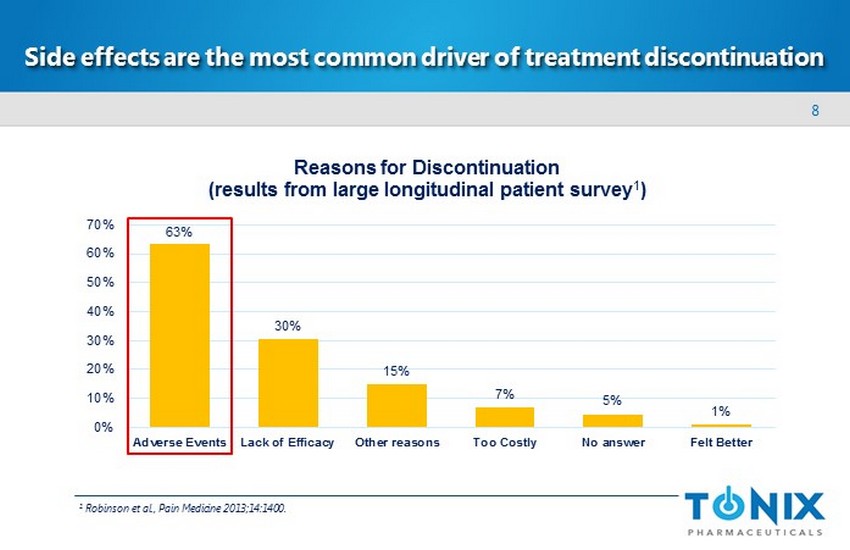
8 Side effects are the most common driver of treatment discontinuation 1 Robinson et al., Pain Medicine 2013;14:1400. 63% 30% 15% 7% 5% 1% 0% 10% 20% 30% 40% 50% 60% 70% Adverse Events Lack of Efficacy Other reasons Too Costly No answer Felt Better Reasons for Discontinuation (results from large longitudinal patient survey 1 )
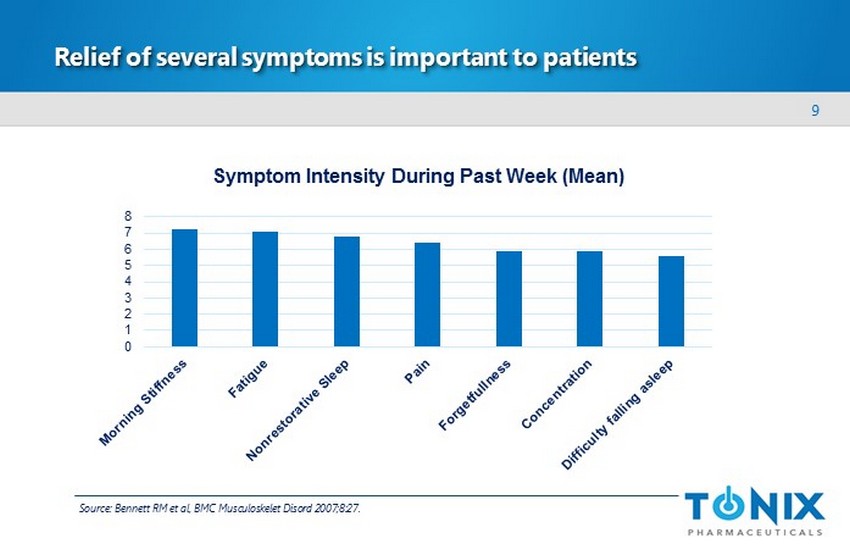
9 0 1 2 3 4 5 6 7 8 Symptom Intensity During Past Week (Mean ) Relief of several symptoms is important to patients Source: Bennett RM et al, BMC Musculoskelet Disord 2007;8:27.
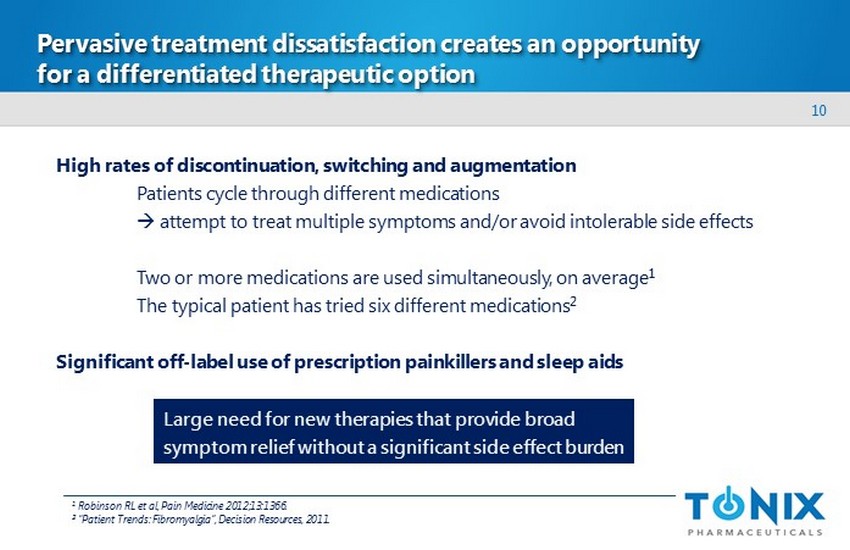
10 1 Robinson RL et al, Pain Medicine 2012;13:1366. 2 “Patient Trends: Fibromyalgia”, Decision Resources, 2011. High rates of discontinuation, switching and augmentation Patients cycle through different medications ; a ttempt to treat multiple symptoms and/or avoid intolerable side effects Two or more medications are used simultaneously, on average 1 The typical patient has tried six different medications 2 Significant off - label use of prescription painkillers and sleep aids Pervasive treatment dissatisfaction creates an opportunity for a differentiated therapeutic option Large need for new therapies that provide broad symptom relief without a significant side effect burden
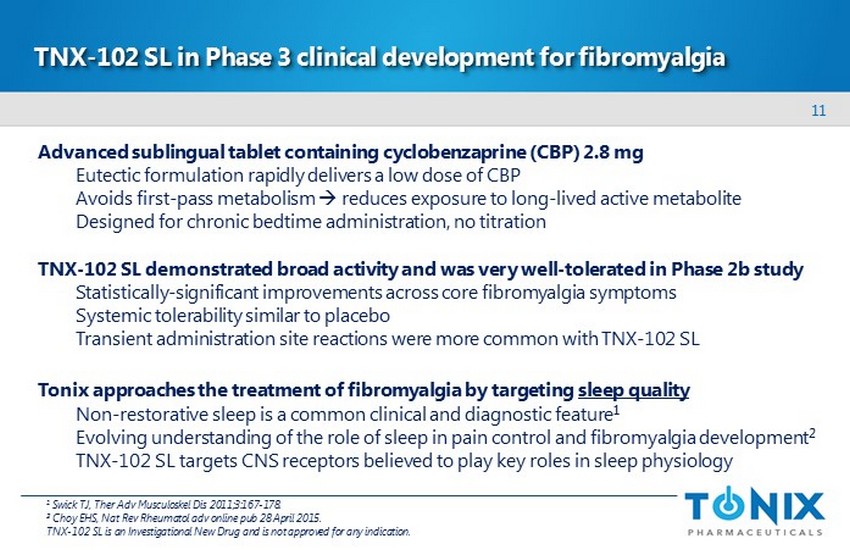
11 Advanced sublingual tablet containing cyclobenzaprine ( CBP) 2.8 mg Eutectic formulation rapidly delivers a low dose of CBP Avoids first - pass metabolism ; reduces exposure to long - lived active metabolite Designed for chronic bedtime administration, no titration TNX - 102 SL demonstrated broad activity and was very well - tolerated in Phase 2b study Statistically - significant improvements across core fibromyalgia symptoms Systemic tolerability similar to placebo Transient a dministration site reactions were more common with TNX - 102 SL Tonix approaches the treatment of fibromyalgia by targeting sleep quality Non - restorative sleep is a common clinical and diagnostic feature 1 Evolving understanding of the role of sleep in pain control and fibromyalgia development 2 TNX - 102 SL targets CNS receptors believed to play key roles in sleep physiology 1 Swick TJ, Ther Adv Musculoskel Dis 2011;3:167 - 178 . 2 Choy EHS, Nat Rev Rheumatol adv online pub 28 April 2015. T NX - 102 SL is an Investigational New Drug and is not approved for any indication . TNX - 102 SL in Phase 3 clinical development for fibromyalgia
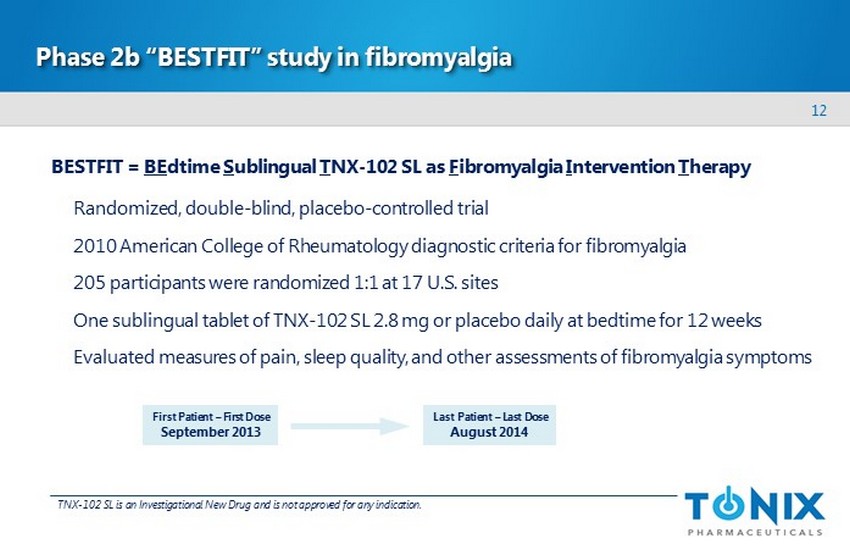
12 Phase 2b “BESTFIT” study in fibromyalgia BESTFIT = BE dtime S ublingual T NX - 102 SL as F ibromyalgia I ntervention T herapy Randomized , double - blind, placebo - controlled trial 2010 American College of Rheumatology diagnostic criteria for fibromyalgia 205 participants were randomized 1:1 at 17 U.S. sites One sublingual tablet of TNX - 102 SL 2.8 mg or placebo daily at bedtime for 12 weeks Evaluated measures of pain, sleep quality, and other assessments of fibromyalgia symptoms First Patient – First Dose September 2013 Last Patient – Last Dose August 2014 TNX - 102 SL is an Investigational New Drug and is not approved for any indication.
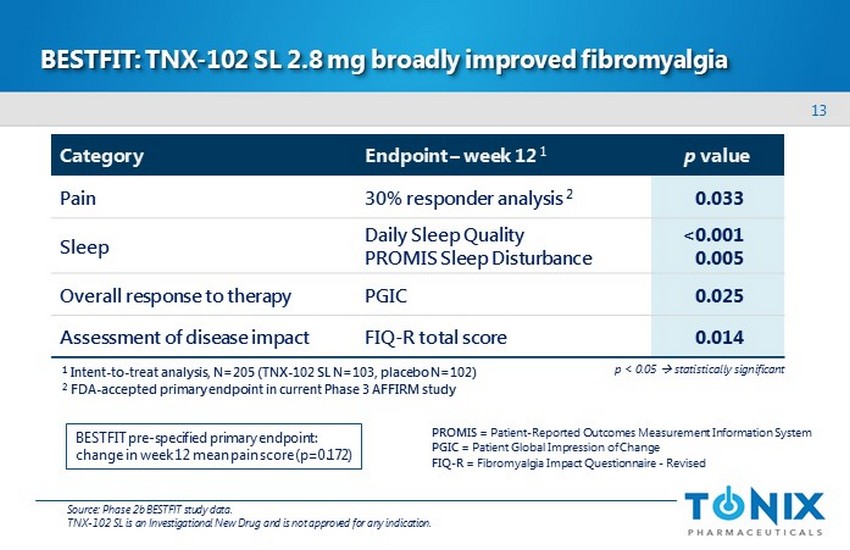
13 BESTFIT: TNX - 102 SL 2.8 mg broadly improved fibromyalgia Category Endpoint – week 12 1 p value Pain 30% responder analysis 2 0.033 Sleep Daily Sleep Quality PROMIS Sleep Disturbance <0.001 0.005 Overal l response to therapy PGIC 0.025 Assessment of disease impact FIQ - R total score 0.014 1 Intent - to - treat analysis, N=205 (TNX - 102 SL N=103, placebo N=102 ) 2 FDA - accepted primary endpoint in current Phase 3 AFFIRM study Source: Phase 2b BESTFIT study data. TNX - 102 SL is an Investigational New Drug and is not approved for any indication. BESTFIT pre - specified primary endpoint: change in week 12 mean pain score (p=0.172) PROMIS = Patient - Reported Outcomes Measurement Information System PGIC = Patient Global Impression of Change FIQ - R = Fibromyalgia Impact Questionnaire - Revised p < 0.05 ; s tatistically significant

14 TNX - 102 SL 2.8 mg was very well tolerated in the BESTFIT study No serious adverse events (SAE) reported with TNX - 102 SL Most frequent local adverse events were administration site reactions Previously reported in TNX - 102 SL Phase 1 studies; no detectable bias on efficacy results Transient tongue numbness (42% TNX - 102 SL vs. 1% placebo ) Abnormal taste (8% TNX - 102 SL vs. 0% placebo) Trial completion rates of 86% with TNX - 102 SL vs. 83% with placebo Systemic adverse events reported by at least 3.0% of the total study population TNX - 102 SL, 2.8 mg (N=103) Placebo (N=101) Total (N=204) Somnolence 1.9 6.9 4.4 Dry Mouth 3.9 4.0 3.9 Back Pain 4.9 3.0 3.9 Source: Phase 2b BESTFIT study data. TNX - 102 SL is an Investigational New Drug and is not approved for any indication.
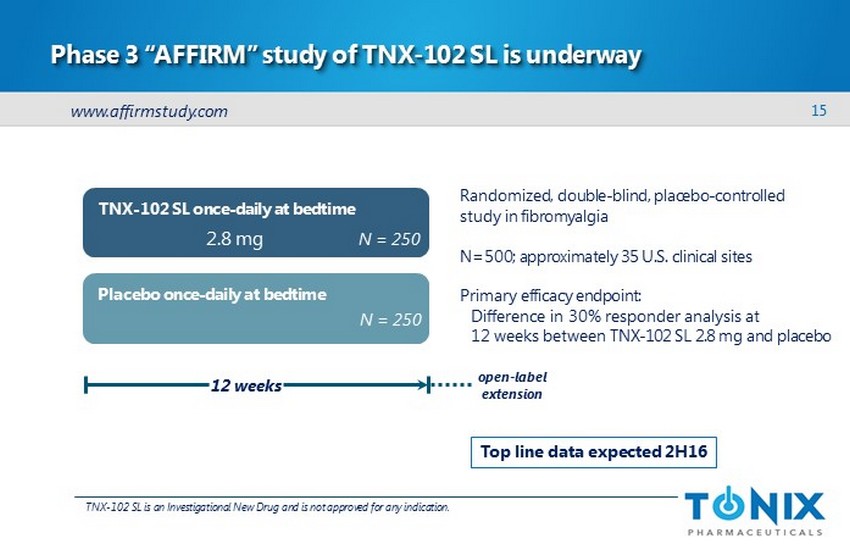
15 Phase 3 “AFFIRM” study of TNX - 102 SL is underway Randomized, double - blind, placebo - controlled study in f ibromyalgia N=500; approximately 35 U.S . clinical sites Primary efficacy endpoint: Difference in 30 % responder analysis at 12 weeks between TNX - 102 SL 2.8 mg and placebo Placebo once - daily at bedtime 12 weeks TNX - 102 SL once - daily at bedtime N = 250 N = 250 2.8 mg open - label extension TNX - 102 SL is an Investigational New Drug and is not approved for any indication . Top line data expected 2H16 www.affirmstudy.com

16 TNX - 102 SL in development for PTSD Preclinical Phase 1 NDA Market Candidate Indication Phase 2 Phase 3 TNX - 102 SL TNX - 102 SL TNX - 201 Post - Traumatic Stress Disorder Top line data 1 H 2016 PTSD = post - traumatic stress disorder TNX - 102 SL and TNX - 201 are Investigational New Drugs and are not approved for any indication.
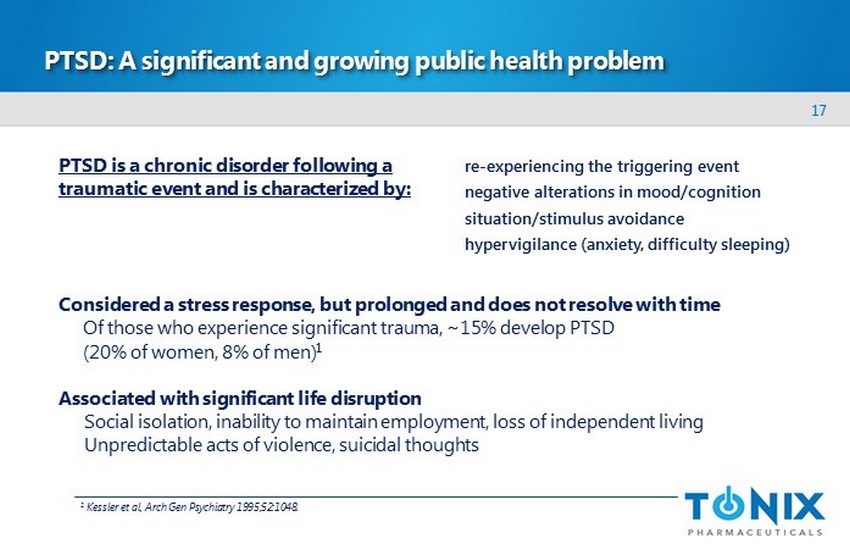
17 PTSD is a chronic disorder following a traumatic event and is characterized by : Considered a stress response, but prolonged and does not resolve with time Of those who experience significant trauma, ~15% develop PTSD (20% of women, 8% of men) 1 Associated with significant life disruption Social isolation, inability to maintain employment, loss of independent living Unpredictable acts of violence, suicidal thoughts PTSD: A significant and growing public health problem 1 Kessler et al, Arch Gen Psychiatry 1995;52:1048. re - experiencing the triggering event negative alterations in mood/cognition situation/stimulus avoidance hypervigilance (anxiety, difficulty sleeping)
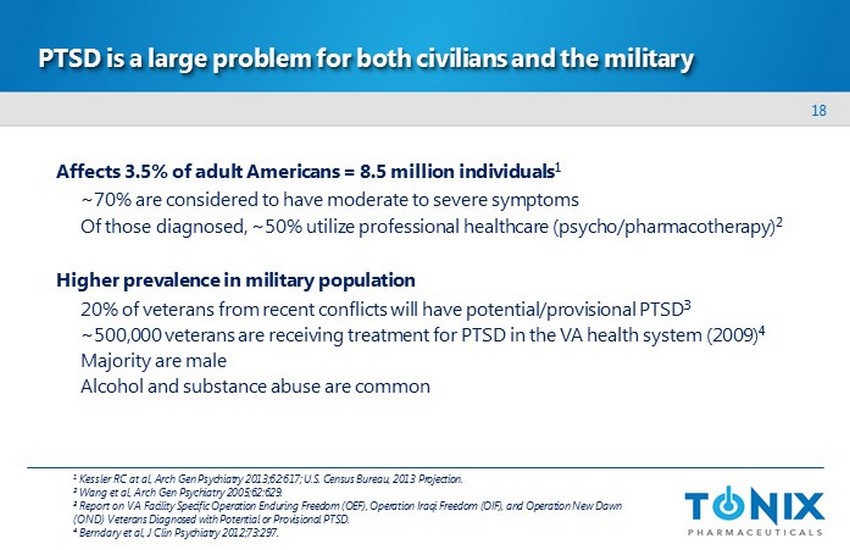
18 Affects 3.5% of adult Americans = 8.5 million individuals 1 ~70% are considered to have moderate to severe symptoms Of those diagnosed, ~50% utilize professional healthcare (psycho/pharmacotherapy) 2 Higher prevalence in military population 2 0 % of veterans from recent conflicts will have potential/provisional PTSD 3 ~ 500,000 veterans are receiving treatment for PTSD in the VA health system (2009) 4 Majority are male Alcohol and substance abuse are common PTSD is a large problem for both civilians and the military 1 Kessler RC at al, Arch Gen Psychiatry 2013;62:617; U.S. Census Bureau, 2013 Projection. 2 Wang et al, Arch Gen Psychiatry 2005;62:629. 3 Report on VA Facility Specific Operation Enduring Freedom (OEF), Operation Iraqi Freedom (OIF), and Operation New Dawn (OND) Veterans Diagnosed with Potential or Provisional PTSD. 4 Berndary et al, J Clin Psychiatry 2012;73:297.
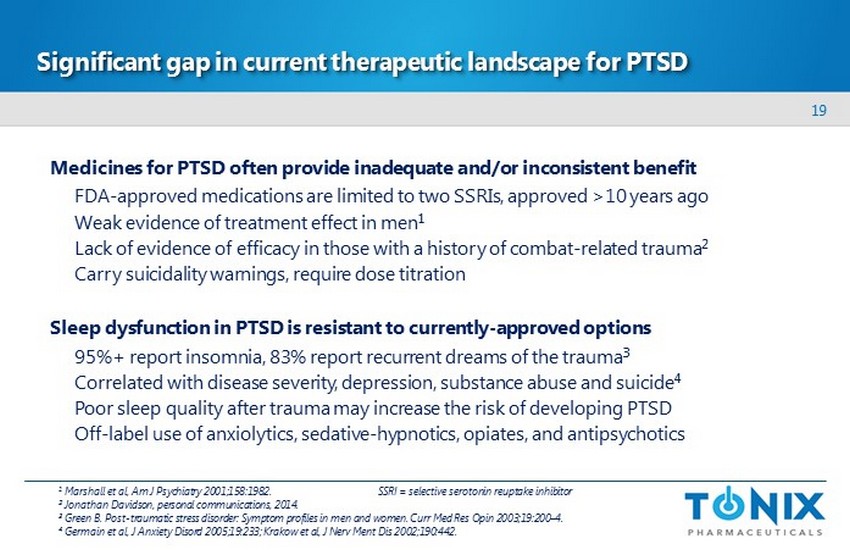
19 Medicines for PTSD often provide inadequate and/or inconsistent benefit FDA - approved medications are limited to two SSRIs, approved >10 years ago Weak evidence of treatment effect in men 1 Lack of evidence of efficacy in those with a history of combat - related trauma 2 Carry suicidality warnings, require dose titration Sleep dysfunction in PTSD is resistant to currently - approved options 95%+ report insomnia, 83% report recurrent dreams of the trauma 3 Correlated with disease severity, depression , substance abuse and suicide 4 Poor sleep quality after trauma may increase the risk of developing PTSD Off - label use of anxiolytics, sedative - hypnotics, opiates, and antipsychotics Significant gap in current therapeutic landscape for PTSD 1 Marshall et al, Am J Psychiatry 2001;158:1982. SSRI = selective serotonin reuptake inhibitor 2 Jonathan Davidson, personal communications, 2014. 3 Green B. Post - traumatic stress disorder: Symptom profiles in men and women. Curr Med Res Opin 2003;19:200 – 4 . 4 Germain et al, J Anxiety Disord 2005;19:233; Krakow et al, J Nerv Ment Dis 2002;190:442.
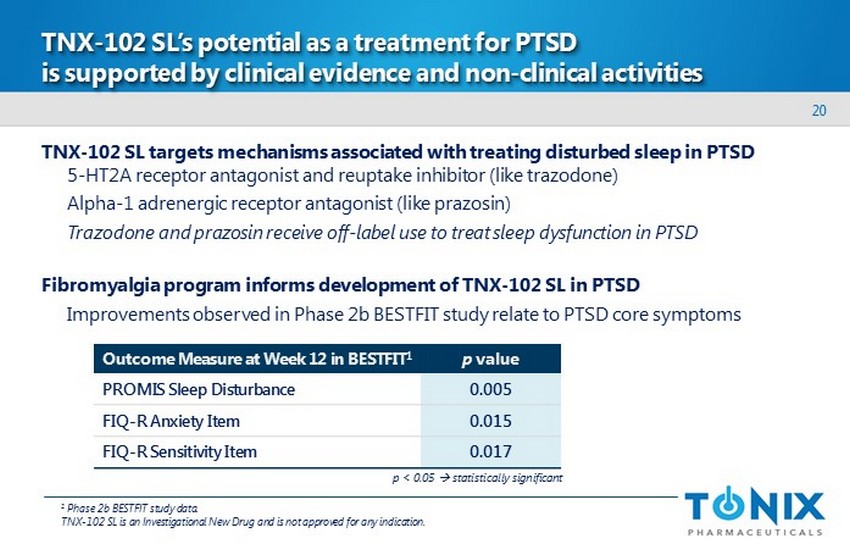
20 TNX - 102 SL’s potential as a treatment for PTSD is supported by clinical evidence and non - clinical activities Outcome Measure at Week 12 in BESTFIT 1 p value PROMIS Sleep Disturbance 0.005 FIQ - R Anxiety Item 0.015 FIQ - R Sensitivity Item 0.017 TNX - 102 SL targets mechanisms associated with treating disturbed sleep in PTSD 5 - HT2A receptor antagonist and reuptake inhibitor (like trazodone) Alpha - 1 adrenergic receptor antagonist (like prazosin ) Trazodone and prazosin receive off - label use to treat sleep dysfunction in PTSD Fibromyalgia program informs development of TNX - 102 SL in PTSD Improvements observed in Phase 2b BESTFIT study relate to PTSD core symptoms 1 Phase 2b BESTFIT study data. TNX - 102 SL is an Investigational New Drug and is not approved for any indication . p < 0.05 ; s tatistically significant

21 Phase 2 “AtEase” trial of TNX - 102 SL in PTSD is ongoing Randomized, double - blind, placebo - controlled trial in military - related PTSD N=220; approximately 25 U.S. clinical sites Primary efficacy endpoint: Difference in Clinician - Administered PTSD Scale (CAPS) score between TNX - 102 SL 2.8 mg and placebo at eight weeks TNX - 102 SL at bedtime once - daily Placebo at bedtime once - daily 12 weeks N = 88 TNX - 102 SL at bedtime once - daily N = 88 N = 44 2.8 mg 5.6 mg open - label extension TNX - 102 SL is an Investigational New Drug and is not approved for any indication . www.ateasestudy.com Top line data expected 1H16
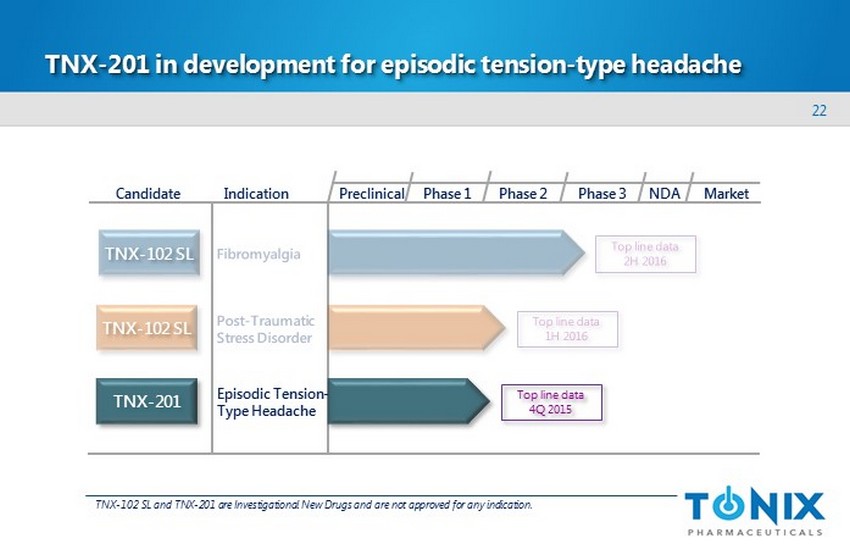
22 TNX - 201 in development for episodic tension - type headache Preclinical Phase 1 NDA Market Candidate Indication Phase 2 Phase 3 TNX - 102 SL TNX - 102 SL TNX - 201 Episodic Tension - Type Headache Top line data 4Q 2015 TNX - 102 SL and TNX - 201 are Investigational New Drugs and are not approved for any indication.
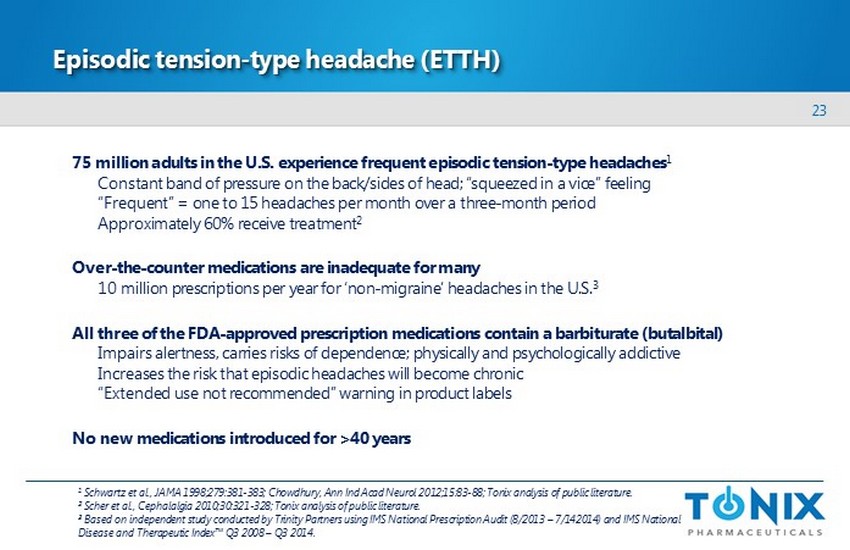
23 Episodic tension - type headache (ETTH) 1 Schwartz et al., JAMA 1998;279:381 - 383; Chowdhury, Ann Ind Acad Neurol 2012;15:83 - 88; Tonix analysis of public literature. 2 Scher et al., Cephalalgia 2010;30:321 - 328; Tonix analysis of public literature . 3 Based on independent study conducted by Trinity Partners using IMS National Prescription Audit (8/2013 – 7/142014) and IMS Nati onal Disease and Therapeutic Index™ Q3 2008 – Q3 2014. 75 million adults in the U.S. experience frequent episodic tension - type headaches 1 Constant band of pressure on the back/sides of head; “squeezed in a vice” feeling “Frequent” = one to 15 headaches per month over a three - month period Approximately 60% receive treatment 2 Over - the - counter medications are inadequate for many 10 million prescriptions per year for ‘non - migraine’ headaches in the U.S. 3 All three of the FDA - approved prescription medications contain a barbiturate ( butalbital ) Impairs alertness , carries risks of dependence; physically and psychologically addictive Increases the risk that episodic headaches will become chronic “Extended use not recommended” warning in product labels No new medications introduced for >40 years
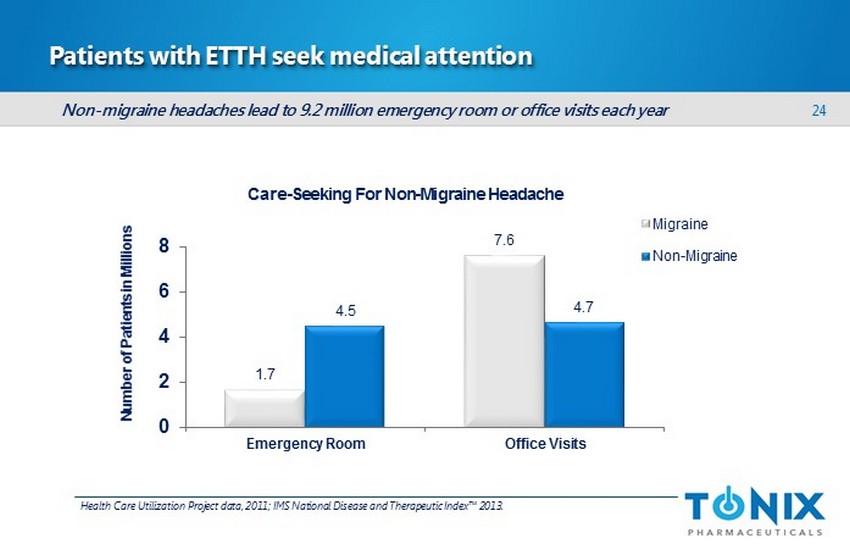
24 Patients with ETTH seek medical attention 1.7 7.6 4.5 4.7 0 2 4 6 8 Emergency Room Office Visits Number of Patients in Millions Care - Seeking For Non - Migraine Headache Migraine Non - Migraine Health Care Utilization Project data, 2011; IMS National Disease and Therapeutic Index™ 2013. Non - migraine headaches lead to 9.2 million emergency room or office visits each year

25 ETTH is the most common type of headache 60% 38% 13% 2% 0% 20% 40% 60% All Headaches ETTH Migraine Chronic One - Year Prevalence Rate for U.S. Adult Population (18 - 65) Adults (18 - 65) 1 1 Schwartz et al., JAMA 1998;279:381; U.S. Census Bureau, 2013 Projection. 2 Stovner et al, Cephalalgia 2007;27(3 ): 193 - 210. • 63 % of all headaches 2 • 80% of all non - migraine headaches • “non - migraine ” consists primarily of ETTH; >70% female ~119 M ~75 M ~26 M ~4.4 M 30% of U.S. adults experience frequent ETTH Episodic tension - type headaches account for approximately:
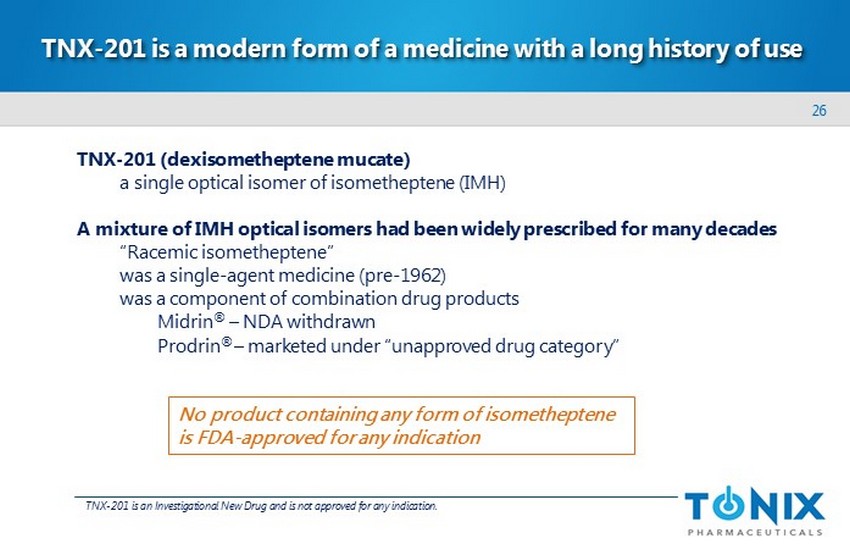
26 TNX - 201 is a modern form of a medicine with a long history of use TNX - 201 ( dexisometheptene mucate ) a single optical isomer of isometheptene (IMH) A mixture of IMH optical isomers had been widely prescribed for many decades “ Racemic isometheptene ” was a single - agent medicine (pre - 1962) was a component of combination drug products Midrin ® – NDA withdrawn Prodrin ® – marketed under “unapproved drug category ” TNX - 201 is an Investigational New Drug and is not approved for any indication. No product containing any form of isometheptene is FDA - approved for any indication
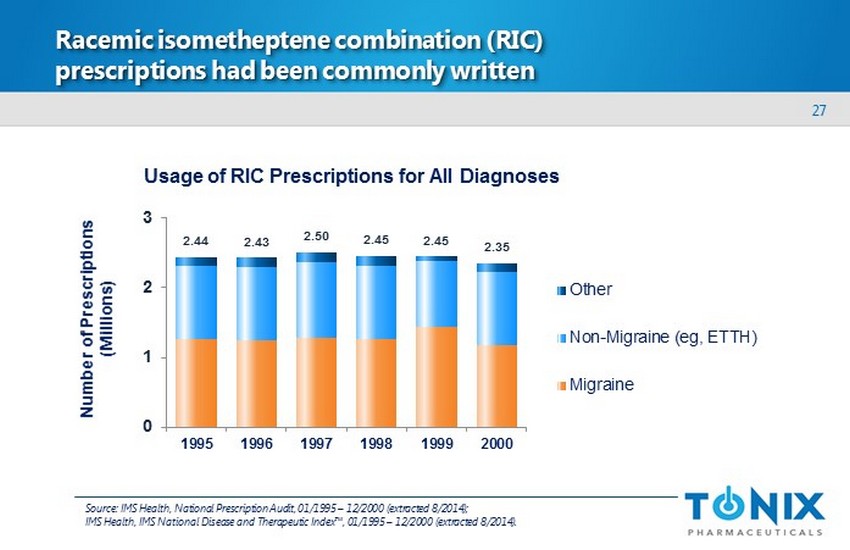
27 Racemic isometheptene combination ( RIC) prescriptions had been commonly written Usage of RIC Prescriptions for All Diagnoses 2.44 2.43 2.50 2.45 2.45 2.35 0 1 2 3 1995 1996 1997 1998 1999 2000 Number of Prescriptions (Millions) Other Non-Migraine (eg, ETTH) Migraine Source : IMS Health, National Prescription Audit, 01/1995 – 12/2000 (extracted 8/2014); IMS Health, IMS National Disease and Therapeutic Index™, 01/1995 – 12/2000 (extracted 8/2014).
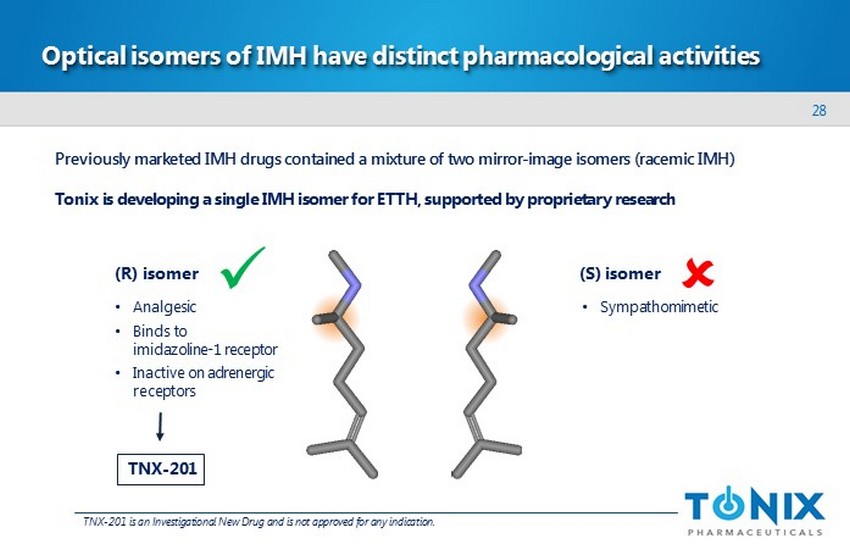
28 Optical isomers of IMH have distinct pharmacological activities (R) isomer (S) isomer • Analgesic • Binds to imidazoline - 1 receptor • Inactive on adrenergic receptors • Sympathomimetic Previously marketed IMH drugs contained a mixture of two mirror - image isomers (racemic IMH) Tonix is developing a single IMH isomer for ETTH, supported by proprietary research x ; TNX - 201 TNX - 201 is an Investigational New Drug and is not approved for any indication.
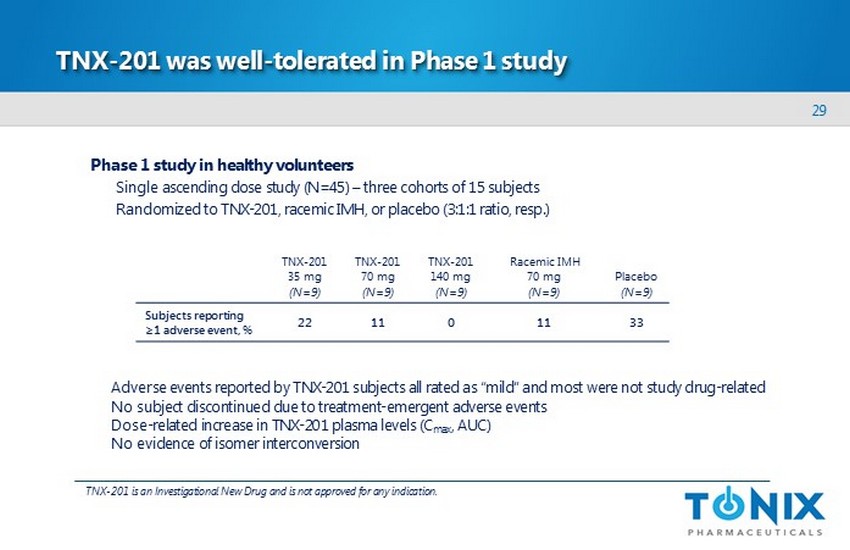
29 TNX - 201 was well - tolerated in Phase 1 study Phase 1 study in healthy volunteers Single ascending dose study (N=45) – three cohorts of 15 subjects Randomized to TNX - 201, racemic IMH, or placebo (3:1:1 ratio, resp.) TNX - 201 is an Investigational New Drug and is not approved for any indication. TNX - 201 35 mg (N=9) TNX - 201 70 mg (N=9) TNX - 201 140 mg (N=9) Racemic IMH 70 mg (N=9) Placebo (N=9) Subjects reporting ≥1 adverse event, % 22 11 0 11 33 Adverse events reported by TNX - 201 subjects all rated as “mild” and most were not study drug - related No subject discontinued due to treatment - emergent adverse events Dose - related increase in TNX - 201 plasma levels ( C max , AUC) No evidence of isomer interconversion

30 Proof - of - concept Phase 2 trial of TNX - 201 in ETTH TNX - 201 is an Investigational New Drug and is not approved for any indication. Randomized, double - blind, placebo - controlled trial in episodic tension - type headache N=200 ; approximately 10 U.S. clinical sites Top line data expected 4Q15 Placebo TNX - 201 N = 100 N = 100 140 mg A proof - of - concept study to evaluate: Proportion of subjects who report “pain free” at several intervals post - dose Proportion of subjects who use rescue medication during the 24 hours post - dose Change from baseline in pain severity score at several intervals post - dose No FDA clinical guidelines on tension - type headache; N o ETTH drug approved in over four decades ; Expect to discuss Phase 3 program design with FDA at End - of - Phase 2 meeting
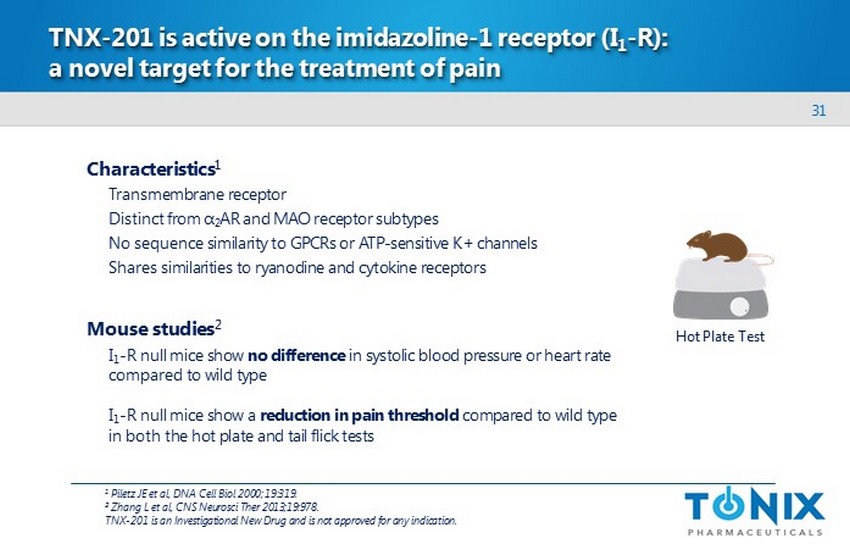
31 TNX - 201 is active on the imidazoline - 1 receptor ( I 1 - R): a novel target for the treatment of pain Hot Plate Test Characteristics 1 Transmembrane receptor Distinct from α 2 AR and MAO receptor subtypes No sequence similarity to GPCRs or ATP - sensitive K+ channels Shares similarities to ryanodine and cytokine receptors Mouse studies 2 I 1 - R null mice show no difference in systolic blood pressure or heart rate compared to wild type I 1 - R null mice show a reduction in pain threshold compared to wild type in both the hot plate and tail flick tests 1 Piletz JE et al, DNA Cell Biol 2000; 19:319. 2 Zhang L et al, CNS Neurosci Ther 2013;19:978. TNX - 201 is an Investigational New Drug and is not approved for any indication .
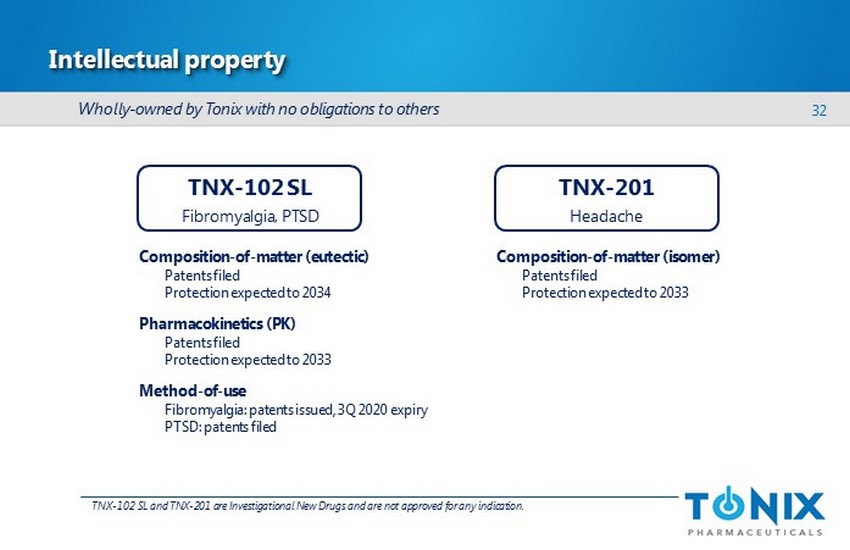
32 Intellectual property Composition - of - matter (eutectic) Patents filed Protection expected to 2034 Pharmacokinetics (PK) Patents filed Protection expected to 2033 Method - of - use Fibromyalgia: patents issued, 3Q 2020 expiry PTSD: patents filed TNX - 102 SL Fibromyalgia, PTSD TNX - 201 Headache Composition - of - matter (isomer) Patents filed Protection expected to 2033 Wholly - owned by Tonix with no obligations to others TNX - 102 SL and TNX - 201 are Investigational New Drugs and are not approved for any indication.
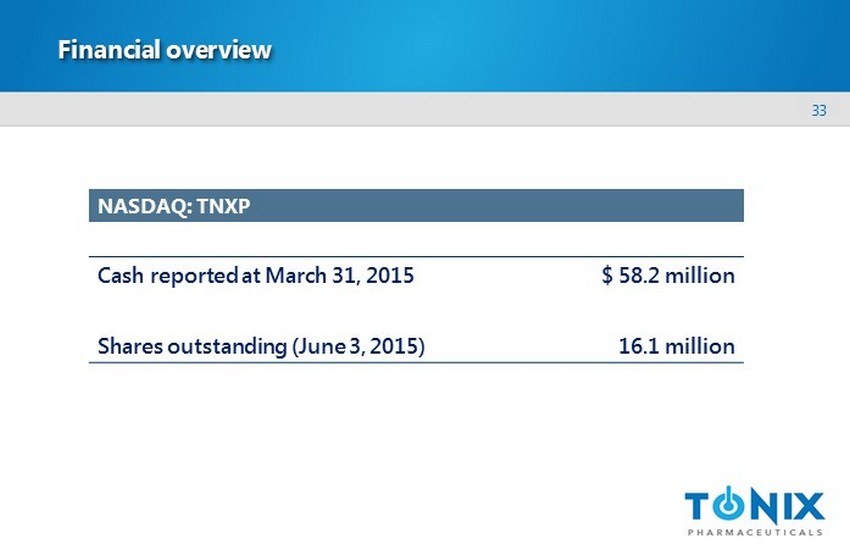
33 Financial overview NASDAQ: TNXP Cash reported at March 31 , 2015 $ 58.2 million Shares outstanding ( June 3, 2015) 16.1 million
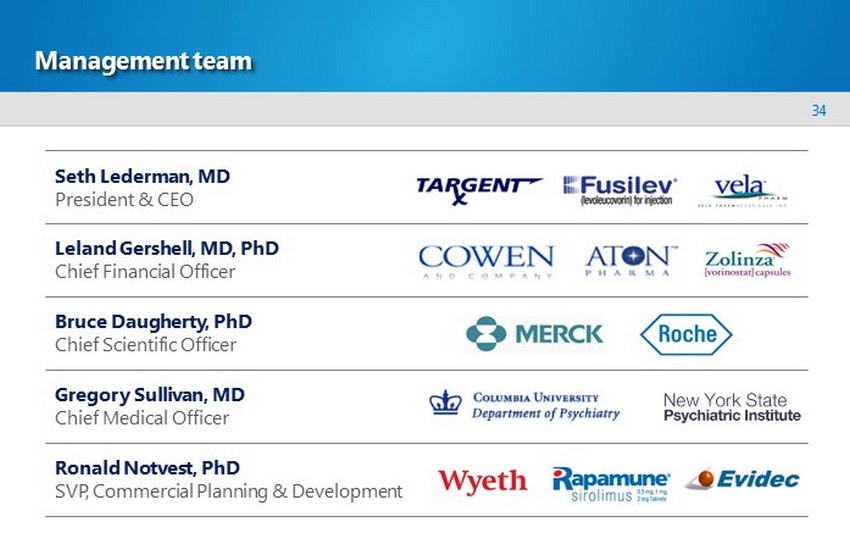
34 Seth Lederman, MD President & CEO Leland Gershell, MD, PhD Chief Financial Officer Bruce Daugherty, PhD Chief Scientific Officer Ronald Notvest, PhD SVP, Commercial Planning & Development Gregory Sullivan, MD Chief Medical Officer Management team
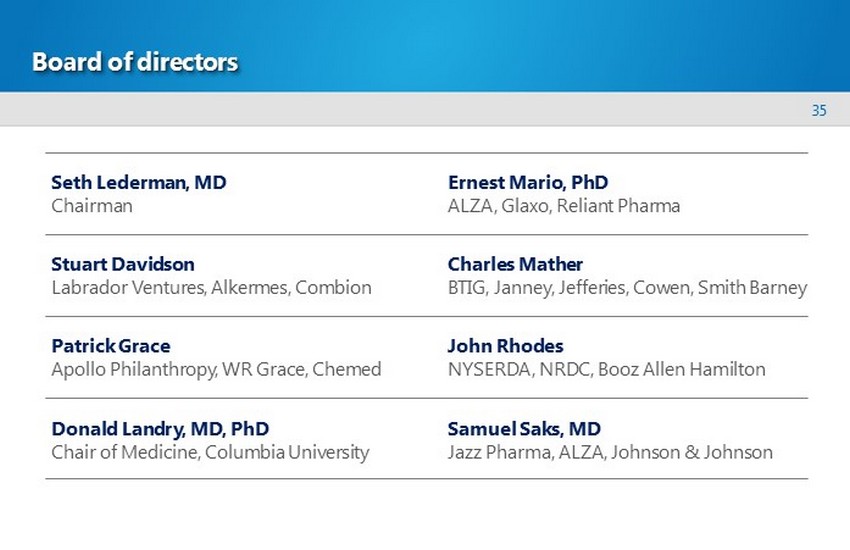
35 Seth Lederman, MD Chairman Ernest Mario, PhD ALZA, Glaxo, Reliant Pharma John Rhodes NYSERDA, NRDC, Booz Allen Hamilton Samuel Saks, MD Jazz Pharma, ALZA, Johnson & Johnson Charles Mather BTIG, Janney, Jefferies, Cowen, Smith Barney Stuart Davidson Labrador Ventures, Alkermes , Combion Patrick Grace Apollo Philanthropy, WR Grace, Chemed Donald Landry, MD, PhD Chair of Medicine, Columbia University Board of directors
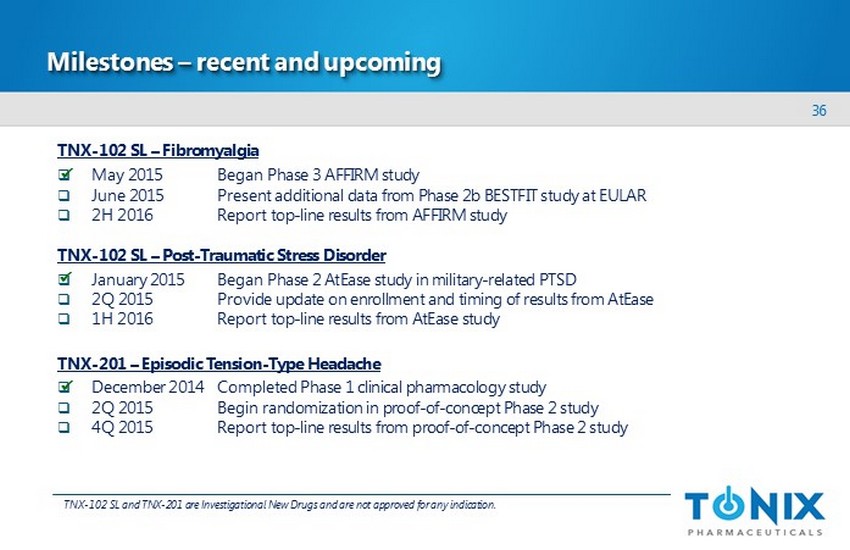
36 TNX - 102 SL – Fibromyalgia □ May 2015 Began Phase 3 AFFIRM study □ June 2015 Present additional data from Phase 2b BESTFIT study at EULAR □ 2H 2016 Report top - line results from AFFIRM study TNX - 102 SL – Post - Traumatic Stress Disorder □ January 2015 Began Phase 2 AtEase study in military - related PTSD □ 2Q 2015 Provide update on enrollment and timing of results from AtEase □ 1H 2016 Report top - line results from AtEase study TNX - 201 – Episodic Tension - Type Headache □ December 2014 Completed Phase 1 clinical pharmacology study □ 2Q 2015 Begin randomization in proof - of - concept Phase 2 study □ 4Q 2015 Report top - line results from proof - of - concept Phase 2 study x x x Milestones – recent and upcoming TNX - 102 SL and TNX - 201 are Investigational New Drugs and are not approved for any indication.

37 Developing innovative medicines for large and growing markets Common and chronic disorders of the central nervous system ( CNS) Next - generation medicines with transformative treatment potential Late - stage candidates supported by human experience C apitalized to achieve key readouts in all of our clinical - stage programs
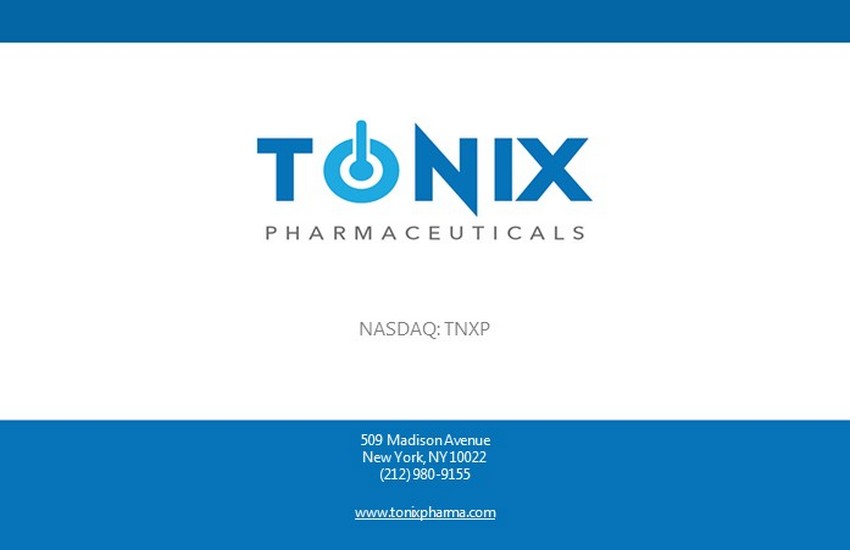
NASDAQ: TNXP 509 Madison Avenue New York, NY 10022 (212) 980 - 9155 www.tonixpharma.com